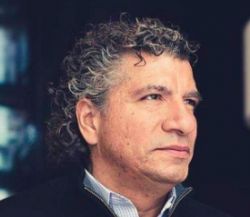|
Symphony
FROM THE NEW WORLD TO THE OLD WORLD
by Peter Lert
Saturday, June 14, 2025
Chamber
MC2 DUO RECITAL CLOSES 222'S SEASON
by Terry McNeill
Saturday, June 14, 2025
Choral and Vocal
CANTIAMO SONOMA'S LUSCIOUS A CAPELLA SINGING IN SEASON ENDING CONCERT
by Pamela Hicks Gailey
Sunday, June 8, 2025
Symphony
SRS SEASON ENDS WITH RESOUNDING TA-TA-TA-BANG
by Terry McNeill
Sunday, June 1, 2025
Symphony
YOUTHFUL VIRTUOSITY ON DISPLAY AT USO'S MAY CONCERTS
by Peter Lert
Saturday, May 17, 2025
Symphony
MYSTICAL PLANETS AND LIVELY GERSHWIN ORTIZ AT FINAL SRS CONCERT
by Peter Lert
Sunday, May 4, 2025
Symphony
VSO'S CONCERT MUSIC OF TIME, MUSIC OF PLACE
by Peter Lert
Sunday, April 27, 2025
VOCAL ELEGANCE AND FIRE AT THE 222'S RECITAL APRIL 26
by Pamela Hicks Gailey
Saturday, April 26, 2025
CANTIAMO SONOMA SINGS AN INSPIRED GOOD FRIDAY MOZART REQUIEM CONCERT
by Pamela Hicks Gailey
Friday, April 18, 2025
DRAMATIC SHOSTAKOVICH SYMPHONY CLOSES PHILHARMONIC'S 25TH SEASON
by Terry McNeill
Sunday, April 13, 2025
|
 |
 Conductor Giancarlo Guerreo |
POLISH MUSICAL WORLDS GLOW BRIGHT IN NFM WROCLAW WEILL PERFORMANCE
by Sonia Morse Tubridy
Saturday, February 1, 2020
The NFM Wroclaw Philharmonic, with conductor Giancarlo Guerrero, gave a concert of enormous energy and emotional impact on Feb.1 to a small audience in Weill Hall. This orchestra has been a major cultural force in Poland since 1949, playing under many renowned conductors and has been committed to presenting Classical and Romantic repertoire as well as 20th and 21st century Polish composers such as Lutoslawski, Pawel Mykietyn and Pärt. Their extensive repertoire extends to European and even American compositions as well.
The program started with Lutoslawski’s Symphonic Variations. The Variations, championed originally by conductor George Fitelberg in Warsaw, begins with a short melodic theme for flute followed by sometimes chaotic sounding sections alternating with returns to the melodic theme. Included in the brilliant orchestral writing are aleatoric sections, times of chance and confusion which then return to order and simplicity, where the musicians play without the direct cues from a conductor.. It was apparent in the first minutes that this was an extraordinary symphony orchestra and Weill Hall acoustics allowed the full richness and variety of timbres to glow and burn bright.
The excitement of great 20th century Polish masters continued with the Szymanowski’s Violin Concerto No. 1. Joining the orchestra was Bomsori Kim, an exciting and brilliant violinist soloist. After moving from the Ukraine to Warsaw Szymanowski wrote this splendid work consisting of one long movement divided into three sections, and it seems It was inspired by a romantic love poem and the orientalist movement popular at the time in Paris. Over a landscape of murmuring orchestral sounds the violin soars in high registers, a marvel of delicacy with inner power which Ms. Bomsori executed with breathtaking beauty and clarity throughout the piece. A textured scene with birdlike calls, glissandi and heartwarming rich low viola sounds from the solo violin led back to etherial violin harmonics. High drama and passages of dancelike rhythms and trumpet calls intertwined. The ensemble playing of soloist and orchestra and also within the orchestra itself was magical. Mr. Guererro led with energy and explosive expressiveness. At times he seemed to be a magician, leading from the physical world to transcendent realms, to a heightened sonic reality.
After an intermission, Brahms’ C Minor Symphony (No. 1) Op. 68, recalled an earlier era. Born in 1833, Brahms lived in the symphonic shadow of Beethoven and it took him 14 years to compose his first symphony. It is a symphony with extremes of sound and drama, and It is often relentless in its path and unsettling until the final march to hope and light. The first movement features timpani and driving melodies with moments of calmness headed towards the transforming C Major harmony. The second movement in E major is cheerful with some dark elements lurking. The third movement again has the dual personality of pastoral character juxtaposed with fanfares and a restless pizzicato bass.
The “epic” finale starts with solemnity and a sudden leap into a theme in homage to Beethoven’s ninth symphony, and it is a powerful movement and Mr. Guerrero led the NFM with careful attention to section balances. The climax was exhilarating. This was an orchestral performance of supreme and relentless commitment. It was almost unbearably intense and the true transformative glory of the final C Major was powerful.
A standing ovation brought the conductor back for an encore, a joyful and rollicking Slavonic Dance No. 8 by Dvorák, a composer championed by Brahms. While the orchestra played, clearly enjoying this dance time, Mr. Guerrero sauntered around the stage, interacting with musicians and audience with humorous pantomime. The audience was enchanted!. What followed was more humor, the orchestra playing Strauss’ Thunder and Lightning Waltz while their conductor did an even more extreme pantomime of approval, disapproval, bafflement and all manner of clown expressions.
By the end, the audience was completely in love, with the orchestra, the conductor, and with the wonder of great music.
Nicki Bell contributed to this review
|
